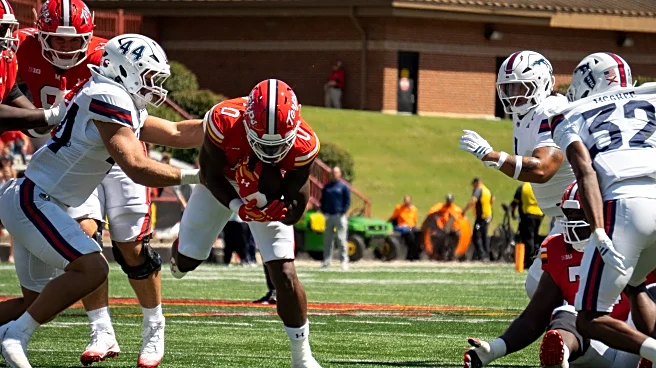Maryland football offensive coordinator Pep Hamilton said before the season his unit would do its best to take pressure off quarterback Malik Washington. That was before the freshman’s early-season performance put the country on notice.
Washington led all freshman quarterbacks in both passing yards (1,038) and touchdowns (8) entering the Terps’ bye week — he’s top-25 regardless of grade in both stats — with just one interception. That’s not even factoring in the abundance of drops his receivers have
accumulated.
But Hamilton was right that putting every game on a freshman’s shoulders isn’t sustainable, no matter how good Washington is. Now in the midst of its Big Ten slate, Maryland’s rushing attack now must bear more responsibility in order to take the next step as an offense.
“Everybody knows that we have athletes and can throw the ball, but in [the] Big Ten you got to win running the football in tough environments, during tough times, in tough weather,” head coach Michael Locksley said. “We’ve started to build our team to fit that type of team that we’re going to have to have at some point.”
The two-man backfield of Roman Hemby and Nolan Ray struggled to create noise in 2024. That problem has only gotten worse this season. 3.6 yards per carry a season ago has become 3.3 yards per carry — and that’s with sack yardage being much less of an issue for Maryland in 2025.
Maryland’s 102.8 rushing yards per game ranks dead last in the Big Ten.
While the Terps’ offensive line has taken a massive step up from 2024, there’s still room for improvement blocking for their running backs. 71.2% of the team’s rushing yards have come after contact, per Pro Football Focus. The team’s longest run of the season is just 18 yards.
This isn’t to say the ground game has been a complete liability. Much of the reason for the Terps’ low output is due to long stretches of garbage time and Maryland’s scheme using screen passes and RPOs effectively as extensions of the run game.
DeJuan Williams’ burst and vision has impressed thus far, and his usage has increased each of the last three weeks. Washington has two rushing touchdowns and looks to be a threat on the ground should Hamilton decide to use him as such.
The biggest issue has been, surprisingly, Ray. The redshirt sophomore was expected to step into a big role with Hemby no longer in the fold, but he’s seen his role diminish greatly in favor of Williams.
The burst that made Ray an exciting player to watch in 2024 has not shown up in 2025. Ray’s first carry in 2024 went for 48 yards — his longest carry in 2025 has been just 11 yards. That’s partially due to a myriad of open holes he’s failed to hit.
Maryland’s offense works best when multiple running backs can be effective. That was Ray and Hemby last season. In 2022 and 2023, Hemby, Antwain Littleton Jr. and Colby McDonald were a three-headed monster at times.
Perhaps it’s Iverson Howard who becomes that change-of-pace back. Howard received extensive playing time against Florida Atlantic and Towson with the games out of hand — he’s clearly the next man up for Locksley.
Regardless of who carries the ball, an average of 3.3 yards per carry must get higher as the season goes on. A 4-0 start has raised expectations — fairly — but without an effective ground game, those expectations will not be met.
“You’ll see us get better at that position,” Locksley said. “They’re talented.”
















